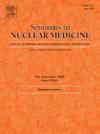神经内分泌肿瘤(NETs)分子成像靶点:综述与最新进展。
IF 5.9
2区 医学
Q1 RADIOLOGY, NUCLEAR MEDICINE & MEDICAL IMAGING
引用次数: 0
摘要
神经内分泌肿瘤(NENs)是一类起源于神经内分泌细胞的肿瘤,具有独特的生物学行为和临床表现。神经内分泌肿瘤(NETs)的发病率一直在上升,需要有效的诊断和治疗策略。分子成像,特别是通过PET和SPECT等技术,在NETs的管理中起着关键作用。本综述强调了生长抑素受体成像在NETs的初始诊断、分期和治疗计划中的重要性,并强调了放射性药物如[68Ga]Ga-DOTATATE和[68Ga]Ga-DOTA-LM3的应用。这些药物具有很高的敏感性和特异性,可以准确地描述疾病的范围和识别隐匿的原发肿瘤。此外,本文还讨论了非生长抑素受体靶点(如葡萄糖代谢和成纤维细胞激活蛋白)在提高分子成像诊断能力方面的新作用。整合先进的成像方式,包括双示踪方法,探索其潜力,以完善治疗策略和改善患者的结果。随着分子成像领域的不断发展,正在进行的研究和临床试验对于验证新型成像剂和技术的有效性和安全性至关重要,最终增强神经内分泌肿瘤患者的管理。本文章由计算机程序翻译,如有差异,请以英文原文为准。
Targets for Molecular Imaging of Neuroendocrine Tumors (NETs): An Overview and Update
Neuroendocrine neoplasms (NENs) represent a diverse group of tumors originating from neuroendocrine cells, characterized by their unique biological behavior and clinical manifestations. The incidence of neuroendocrine tumors (NETs) has been rising, necessitating effective diagnostic and therapeutic strategies. Molecular imaging, particularly through techniques such as PET and SPECT, plays a pivotal role in the management of NETs. This review highlights the significance of somatostatin receptor imaging in the initial diagnostic work-up, staging, and treatment planning for NETs, emphasizing the utility of radiopharmaceuticals like [68Ga]Ga-DOTATATE and [68Ga]Ga-DOTA-LM3. These agents demonstrate high sensitivity and specificity, allowing for accurate delineation of disease extent and identification of occult primary tumors. Furthermore, the review discusses the emerging role of nonsomatostatin receptor targets, such as glucose metabolism and fibroblast activation protein, in enhancing the diagnostic capabilities of molecular imaging. The integration of advanced imaging modalities, including dual-tracer approaches, is explored for their potential to refine therapeutic strategies and improve patient outcomes. As the field of molecular imaging continues to evolve, ongoing research and clinical trials are essential to validate the efficacy and safety of novel imaging agents and techniques, ultimately enhancing the management of patients with neuroendocrine tumors.
求助全文
通过发布文献求助,成功后即可免费获取论文全文。
去求助
来源期刊

Seminars in nuclear medicine
医学-核医学
CiteScore
9.80
自引率
6.10%
发文量
86
审稿时长
14 days
期刊介绍:
Seminars in Nuclear Medicine is the leading review journal in nuclear medicine. Each issue brings you expert reviews and commentary on a single topic as selected by the Editors. The journal contains extensive coverage of the field of nuclear medicine, including PET, SPECT, and other molecular imaging studies, and related imaging studies. Full-color illustrations are used throughout to highlight important findings. Seminars is included in PubMed/Medline, Thomson/ISI, and other major scientific indexes.
 求助内容:
求助内容: 应助结果提醒方式:
应助结果提醒方式:


